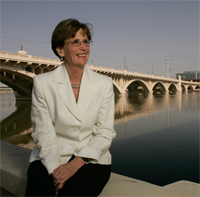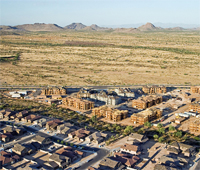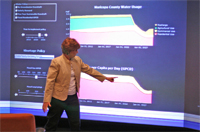September 30, 2009
Q&A with Patricia Gober

Dr. Patricia Gober

Rapid growth on urban fringes exacerbates water supply challenges from climate change

Using WaterSim for decision support in the Decision Theater
Dr. Gober is a professor in the School of Geographical Sciences and Urban Planning and in the School of Sustainability. She is also a Policy Research Associate at Morrison Institute for Public Policy and Co-Director of Decision Center for a Desert City, one of five National Science Foundation-funded centers focused on developing fundamental new knowledge and tools for decision-making under climatic uncertainty.
When did you come to focus on “sustainability” in your research?
I’ve been a “closet” sustainability scientist for as long as I can remember. During more than 30 years interacting with earth scientists, biogeographers, and climatologists, I became more interested in our connections than our differences. Then, in 1998 I was elected president of the Association of American Geographers, which triggered the realization that my field — geography — was a potent catalyst for the marriage of science, social science, technology, and the humanities. Gradually, I moved from there to the long-term perspective, collaborative practices, and solution-oriented work of sustainability science I’m involved with today.
What is your most important sustainability-related research project?
I co-direct the Decision Center for a Desert City (DCDC) to address water management decision-making in the face of climate uncertainty. The premise of our work is that society needs to prepare for the effects of climate change, but even the best climate science will never completely eliminate all unknowns. To mitigate the uncertainty decision-makers must face, we developed WaterSim, a scientific simulation and policy tool that enables them to explore the consequences of different policy scenarios on future water supplies. By asking carefully crafted “what if” questions, applying the best available scientific and institutional knowledge, and collaborating closely with water managers and policymakers, we help identify which choices avoid misfortune and are robust under a range of future climate conditions.
How does your sustainability-related research affect “real world” decisions?
Locally, our goal is to draw attention to the need for climate adaptation in Arizona — particularly to persuade water managers and the public of the need for action. We’ve also worked in collaboration with the city of Phoenix’s Water Services Department to investigate the consequences of using irrigated landscaping to mitigate the urban heat island effect.
Thinking globally, the strategies and solutions we find here can be applied to many other rapidly urbanizing regions around the world. In recognition of that, DCDC was chosen as a winner of the Prince Sultan Bin Abdulaziz International Prize for Water in the category of water resources management and protection.
What is the world sustainability challenge that concerns you most?
Increasingly, I focus on the challenge of sustainable cities. We can no longer discuss urban water, land, or energy decisions without examining their consequences for maintaining healthy ecosystems, supporting economic progress, feeding the world’s population, and managing the risk of shortages across social groups and communities. The challenge for the world’s cities is to look at the interconnectedness of their social, economic, and environmental systems and policies. Water is but one piece of this complex puzzle.
September 30, 2009

